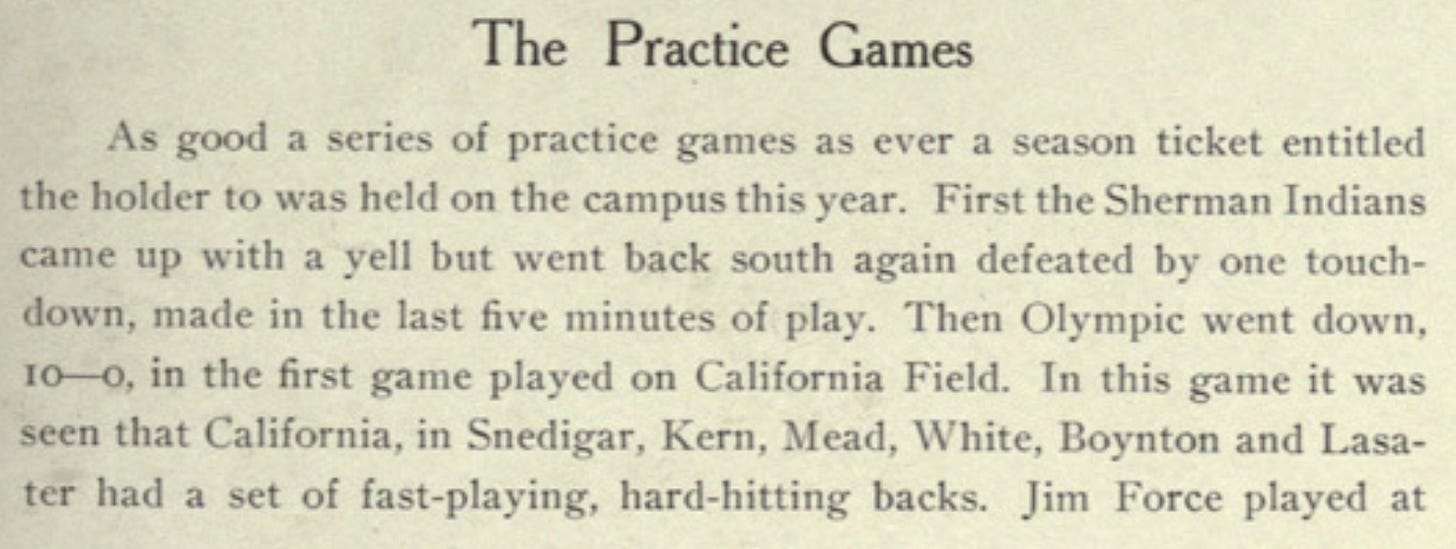Today's Tidbit... Procrastination and the 1904 Cal-Stanford Game
Words to live by: The best time to finish things is at the last minute. Never do today what you can put off until tomorrow.
I'll get back to that thought momentarily, but let's talk about the 1904 Cal-Stanford game, the first Big Game played on either team's campus. Many schools in the 1800s and early 1900s played big games at major or minor league baseball parks because those were the biggest stadiums with the most seating capacity. Only a handful of schools nationwide had on-campus stadiums that sat 10,000 people. Harvard, Yale, Princeton, Penn, and Chicago could pull it off, but not many others. Before 1904, they played the Big Game at neutral sites in San Francisco, but once Cal built California Field, it made sense to play the 1904 game in Berkeley.
Cal entered the game at 6-0 while Stanford was 5-2-1 after both teams faced the always tough San Francisco Olympic Club, Oregon, and the Sherman Institute, then the Carlisle of the West. While both teams had played the best competition on the West Coast, even those games were considered inconsequential compared to the Big Game, as shown by Cal's yearbook categorizing all non-Stanford games as practice games.
Having set up the importance of the game, it's about time we talk about procrastination. Regular readers know I enjoy RPPCs (Real Photo Postcards) that illustrate elements of football we don't see much anymore. The notoriety of the teams in an RPPC is less significant than the concept illustrated, so I was happy to acquire the image below. Mailed in November 1906, the photo shows a pre-game moment at the 1904 Big Game. We know it is the 1904 game since California Field opened that year, and the Stanford students in the stands under a large sign match a similar image in the 1906 Cal yearbook. (College yearbooks then were commonly published by the junior class for the senior class, so Cal's Class of 1906 yearbook covered the 1904-1905 academic year and 1904 football season.) Also, the 1905 game occurred at Stanford, and both schools dropped football before 1906, so the picture had to be from 1904.

Game action with the Lucky Jim sign in the background (1906 Stanford yearbook)
The sign behind the Stanford section was an attempt to tease Cal tight tackle Jim Force. America was still in the early stages of transitioning to breakfast cereal. Force was the country's first successful wheat bran breakfast cereal, following the success of other wheat cereals like Shredded Wheat and Cream of Wheat. Force advertising included a cartoon character named Sunny Jim, pictured in the sign. While the sign is not particularly funny to the sensibilities of the 2020s, perhaps I don't get sophisticated Stanford humor.
Anyway, press reports about the game and the stories in the school yearbooks indicate that students from both schools took their seats two hours before kickoff and spent the next 120 minutes trying to shout the opposing student body into submission. Packing the stands with sober students two hours before game time is impressive and explains they were there when the procrastinating grounds crew was still striping the checkerboard field. Thankfully, the photographer captured this moment as it must be one of the few images of a grounds crew striping a checkerboard field.
The checkerboard field had lines five yards apart running perpendicular to the yard lines to assist the officials in judging the legality of specific runs, and passes after 1905. When the image was taken, the grounds crew had applied only three of the eleven cross stripes despite the game starting in an hour or so. Better late than never, I guess.
Game images show the field was fully striped by game time, as Cal took the field wearing brand-new blue jerseys that helped sustain their efforts against the bigger and stronger Stanford crew. The Bears allowed Stanford inside the 5-yard line in the first half. When Stanford aligned in a tandem formation with several backs lined up behind a tackle, Cal's captain yelled "Shift," and the defense realigned and stopped Stanford's tandem play, even pushing them back two yards. Later in the half Stanford attempted a dropkicked field goal from the 12-yard line, but Cal blocked it to end the second scoring threat in the first half.
After fighting gamely in the first half, the Cal players wore down in the latter stanza as a second, third, and fourth starter left the game due to injury. Stanford, whose seniors had played Michigan on January 1, 1902, in a game that would only become viewed as the first Rose Bowl game in the 1930s, kept coming at the Bears and scored 18 points to claim the victory.


Both schools played football in 1905 before dropping the sport in 1906, playing rugby instead. California was not yet the trendsetting state it became since only a few schools outside California followed their lead and dropped gridiron football. Cal put off their return to football for a decade, returning to football in 1915 and Stanford in 1919.
Football Archaeology is reader-supported. Click here to buy one of my books or otherwise support the site.









The early "Big Games" have had so many interesting story lines. From this 1904 game to the 1900 loss of life disaster, and the 1892 game manager Herbert Hoover forgetting to bring the game ball to the field, and of course the Stanford band game ending! Great research off of the image to identify the game.